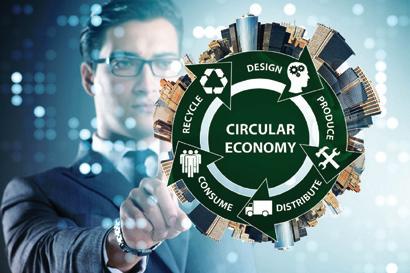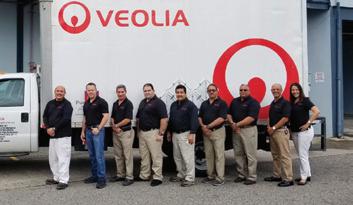
2 minute read
The Circular Economy
What is the circular economy?
The circular economy is a solution for industry and business at all scales to reduce, reuse and recycle waste. This solution extends beyond reducing trash in landfills, reusing products and recycling plastics. The circular economy aims to turn all wastes into a resource by reintroducing them into the production cycle instead of product disposal at the end of their useful life. The circular model is based on three principles:
Advertisement
• Design out waste and pollution
• Keep products and materials in use
• Regenerate natural systems
What is a linear versus circular economy?

Most production processes in the United States follow a linear “take-make-waste” approach, which has caused significant damage to our living environment over the years. With the strain on our natural resources, this outdated linear model is unsustainable.
remanufactured for new uses or the materials recovered and made into new products. By re-thinking how we produce, consume and extend the life of finite resources, materials can be recycled or leveraged further in a continuous flow, generating resource savings, protecting supplies, maintaining materials at their highest value and reducing carbon footprint. By shifting our economic models from a linear into a circular economy, we can help turn “take-make-waste” into “made to be made again.”
Why the circular economy is important
Our world is supplied with finite resources. While these resources regenerate, they are doing so at a slower rate than we as populations are extracting them. Many of those finite resources are becoming scarce — clean drinking water, quality soil, natural gas, minerals, precious metals, and more. In the past forty years, annual global extraction of materials has tripled.
“By 2050, the total demand for resources is expected to reach 130 billion tons, up from 50 billion in 2014, a 400% increase”.
By applying a circular economy model, companies can help contribute to the replenishing of Earth’s natural resources while simultaneously extracting more value out of existing materials and resources used in daily operations. Additional benefits include:
• Save money and improve price stability across your entire supply chain
• Pioneer change within your industry, satisfying changing customer needs and shifting markets
• Stay ahead of government regulations and new requirements
• Empower your employees with a message of positive change
• Gain customer loyalty and improve your brand recognition
90% of used global resources are not reused
Applying the Circular Economy to your Business


When implementing circular concepts into your business plan there are certain tipping points that greatly affect the success of adoption.
Let the data drive decisions
All company structures and processes are different, each with unique opportunities to maximize efficiency and reduce waste through evaluating current resource use and applying one or more circular concept to their current process. Collect all relevant production data to gain a more holistic view of what and how resources are used in your company’s processes.
Engage Stakeholders Early
Identify both the primary and secondary stakeholders. By what parameters will the shift to circular processes be evaluated? It’s likely that your company already has goals around sustainability, but what overarching changes can be considered? These conversations must engage top stakeholders early as they will be critical in seeing the initiative through.
Consider All Forms of Circularity
The circular economy can present in many forms - its ever-evolving and a profound opportunity for creative applications of circular concepts to make an impact on not only cost savings but also our planet’s limited resources. Resource recovery, sharing models, product life extension, service as a product model, and circular supplies models all manifest circularity in different ways.
Consult with Experts
Research, conversation, and due diligence are all critical processes in the transition to a more circular business model. Environmental service companies can be useful in helping to gather the right data and see potential solutions in a new light. While there are endless combinations of circular activity, finding the right processes to implement can be challenging.




